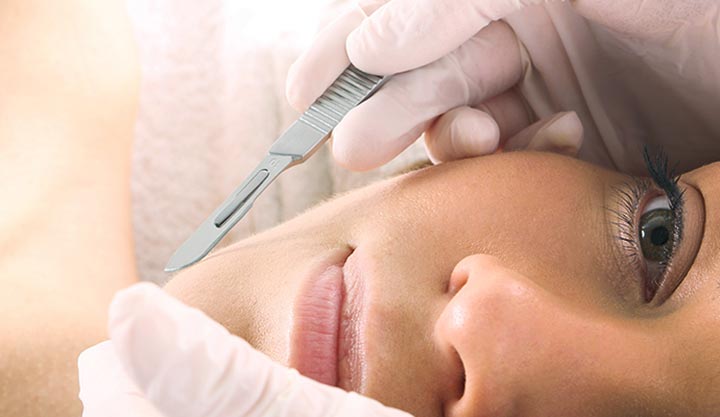WHAT IS DERMAPLANING AND EXTRACTION
Dermaplaning is a minimally invasive cosmetic procedure for your skin. It uses a special instrument to shave away the uppermost layers of your skin.
Dermaplaning can help reduce the appearance of acne scars or other skin imperfections by revealing newer, undamaged skin. It can make your skin look younger; though, it doesn’t stop the aging process. Some people also get dermaplaning for hair removal. This is only a temporary fix because your hair will grow back.
Most people get the procedure on their face, but you can do it anywhere on your body.

What is dermaplaning?
Dermaplaning is a minimally invasive cosmetic procedure for your skin. Your healthcare provider uses a special instrument to shave away the uppermost layers of your skin.
Dermaplaning can help reduce the appearance of acne scars or other skin imperfections by revealing newer, undamaged skin. It can make your skin look younger; though, it doesn’t stop the aging process. Some people also get dermaplaning for hair removal. This is only a temporary fix because your hair will grow back.
Most people get the procedure on their face, but you can do it anywhere on your body.
Dermaplaning vs. dermabrasion vs. microdermabrasion: What’s the difference?
Dermaplaning, dermabrasion and microdermabrasion are all skin resurfacing procedures. Each procedure uses different tools and takes off different amounts of skin. Dermaplaning uses a scalpel (knife) or razor to remove skin. Dermabrasion is a surgical procedure. Microdermabrasion is a nonsurgical procedure that uses an exfoliating blade to sand away your skin to smooth it and remove the appearance of scars.
Who gets dermaplaning?
You may consider dermaplaning if you have skin concerns such as:
- Acne scars.
- Actinic keratosis (scaly skin patches that can lead to skin cancer).
- Dull or dry skin.
- Peach fuzz (light, soft hair on your face).
- Skin damaged by sun exposure.
- Fine lines (wrinkles).
Who shouldn’t have dermaplaning?
Some people with preexisting skin concerns shouldn’t have dermaplaning. Before getting this procedure, talk to your Beautician if you have:
- An active case of acne.
- Cold sore outbreaks.
- Eczema.
- Moles, freckles, skin tags or other skin growths.
- Psoriasis.
- Skin burns, such as those from radiation therapy.
- Skin rashes (contact dermatitis).
What are the risks of dermaplaning?
Dermaplaning is generally considered a safe cosmetic procedure. However, it does carry the following risks:
- Infection.
- Scarring such as keloid or hypertrophic (raised) scars.
- Skin discoloration (skin that turns lighter or darker than the surrounding skin).
EXTRACTION
Facial skin extractions play a crucial role in maintaining healthy, clear skin. Our skin is constantly exposed to various pollutants, bacteria, and dead skin cells. Over time, these impurities can accumulate and clog our pores, leading to the formation of blackheads, whiteheads, and other blemishes.
Extractions help to remove these blockages, allowing the skin to breathe and preventing further breakouts. By clearing out the pores, extractions promote a smoother complexion and improve the effectiveness of other skincare products.
How Facial Extractions Work
Facial extractions involve the manual removal of impurities from the skin, such as blackheads, whiteheads, and pimples. There are several methods of extractions, each with its own benefits and considerations. Let’s take a closer look at the most common techniques:
- Manual Extractions: This method involves using specialized tools, such as comedone extractors, to gently press and release the contents of clogged pores. It requires precision and a delicate touch to avoid damaging the skin.
- Chemical Extractions: Chemical peels or exfoliants can be used to dissolve the debris and dead skin cells that clog the pores. These products contain ingredients such as alpha-hydroxy acids (AHAs) or beta-hydroxy acids (BHAs) that promote exfoliation and skin renewal.
- Vacuum Extractions: This technique utilizes a suction device to remove impurities from the skin. The vacuum creates a gentle pressure that dislodges the debris, leaving the pores clear.
Each method has its pros and cons, and the choice depends on factors such as skin type, severity of the blemishes, and personal preference. It’s essential to consult with a skincare professional or dermatologist to determine the most suitable extraction method for your skin.
Aftercare tips for facial skin extractions
After undergoing facial extractions, it’s crucial to provide proper care to your skin to minimize any potential side effects and promote healing. Here are some aftercare tips to follow:
- Avoid Touching Your Face: Resist the temptation to touch or pick at the extracted areas. This can introduce bacteria and increase the risk of infection or scarring.
- Cleanse and Moisturize: Use a gentle cleanser to cleanse your skin and remove any residual debris. Follow up with a lightweight moisturizer to hydrate and nourish the skin.
- Protect Your Skin: Apply a broad-spectrum sunscreen with at least SPF 30 to protect your skin from harmful UV rays. This step is crucial as your skin may be more sensitive after extractions.
By following these aftercare tips, you can help your skin recover and maintain the benefits of the extraction procedure. Now, let’s explore the common types of skin blemishes that can be treated with extractions.
Common types of skin blemishes that can be treated with extractions
Facial extractions are particularly effective in treating various types of skin blemishes. Here are some common issues that can be addressed through extractions:
- Blackheads: These small, dark spots occur when oil and dead skin cells clog the pores and oxidize. Manual extractions or chemical exfoliants can effectively remove blackheads and prevent their recurrence.
- Whiteheads: Whiteheads, also known as closed comedones, are small, flesh-colored bumps that occur when a pore is clogged with oil and dead skin cells. Manual extractions can gently remove whiteheads without causing damage to the surrounding skin.
- Pimples: Pimples, or acne lesions, are inflamed and infected pores. While extractions can help remove the contents of a pimple, it’s important to exercise caution to prevent further inflammation or scarring.
- Milia: Milia are small, white, hard bumps that often occur around the eyes or on the cheeks. These are caused by trapped keratin under the skin’s surface. Manual extractions can effectively remove milia, but it’s important to have a professional perform this procedure to avoid injury to the delicate eye area.
By understanding the specific types of blemishes that can be treated with extractions, you can target your skincare routine more effectively and achieve clearer, healthier skin.
Potential risks and precautions of facial skin extractions
While facial extractions can be highly effective in treating skin blemishes, it’s important to be aware of the potential risks and take necessary precautions. Here are some considerations to keep in mind:
- Skin Sensitivity: Individuals with sensitive skin may be more prone to irritation and redness after extractions. It’s important to communicate any concerns or sensitivities to your skincare professional.
- Infection: If the extraction tools or the skin are not properly sanitized, there is a risk of introducing bacteria and causing infection. Ensure that all tools are clean and sterile before performing extractions.
- Scarring: Excessive force or improper technique during extractions can lead to scarring or post-inflammatory hyperpigmentation. It’s crucial to exercise caution and seek professional help if you’re unsure of the proper technique.
- Post-Extraction Breakouts: In some cases, extractions can cause a temporary increase in breakouts as the skin adjusts. This is known as purging and usually subsides within a few days. However, if the breakouts persist or worsen, it’s advisable to consult with a skincare professional.
By understanding and mitigating these potential risks, you can ensure a safe and effective extraction procedure. Now, let’s address some frequently asked questions about facial skin extractions.
Frequently asked questions about facial skin extractions
- Are facial extractions painful?
Facial extractions can cause mild discomfort, especially in sensitive areas. However, a skilled professional will minimize any pain or discomfort during the procedure. - How often should I get facial extractions?
The frequency of facial extractions depends on your skin type and specific concerns. Generally, it’s recommended to have extractions performed by a professional every 4-6 weeks. - Can I perform extractions at home?
While it’s possible to perform extractions at home, it’s advisable to seek professional help, especially if you’re unsure of the proper technique or have sensitive skin. - Can extractions help with acne scars?
Facial extractions primarily target active blemishes and do not directly treat acne scars. However, by minimizing breakouts and promoting skin renewal, extractions can indirectly improve the appearance of acne scars over time. - Can extractions be done on all skin types?
Extractions can be performed on most skin types, but it’s important to consider individual factors such as skin sensitivity and any underlying skin conditions. Consulting with a skincare professional is crucial to determine the suitability of extractions for your skin.
Book your appointment with our esthetician at Unwind beauty lounge, the best facial spa in Frisco.
